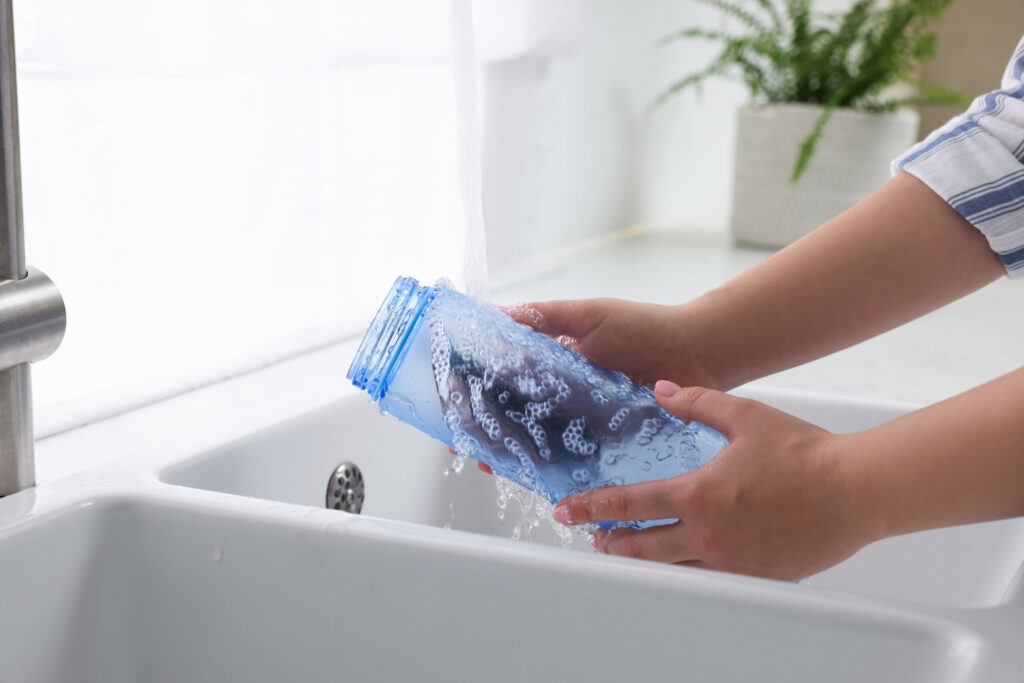Summer has finally arrived, and that means your reusable water bottle will be working overtime keeping you hydrated during these hot, summer days. However, make sure that while you’re staying hydrated, you’re also keeping your reusable bottle as clean as possible. Take our quiz and test your knowledge of which materials are safest, best practices for cleaning, and potential dangers an improperly cleaned bottle can present. Don’t let a dirty water bottle keep you from having the best summer ever!
1. True or false? Without proper cleaning, your water bottle can become an ecosystem of mold and bacteria that will contaminate the water you’re drinking.
2. Which of the following methods are ways that microbials like yeast, bacteria, and mold get into a reusable drinking bottle?
A. From the water itself
B. From you touching the lid or other components
C. From contact with your mouth and saliva while drinking
D. All of the above
3. Which of the following are some of the health effects of consuming mold?
A. Stomach issues like feeling sick to your stomach, stomach cramps, and/or having diarrhea
B. Allergic reactions to mold, like sneezing, coughing, itching, or a runny nose
C. Respiratory problems like difficulty breathing, coughing, or wheezing; it’s generally worse if you have asthma or other lung conditions.
D. Infections, especially if you have a weakened immune system
E. All of the above
4. Which of the following is a sign that mold and/or bacteria is growing in your reusable water bottle?
A. Visible spots inside the bottle that can appear as fuzzy or slimy green, black, or white patches
B. An unpleasant smell and/or taste, such as a musty, slightly earthy smell or taste
C. A cloudy appearance of the water
D. A residue or film inside the bottle with a strange texture or coating
E. All of the above
5. True or false? If you see mold or bacteria growing in your reusable water bottle, it’s okay to finish drinking the water in the bottle before cleaning it.
6. Which of the following actions should you NOT do with your reusable water bottle?
A. Clean it out between every use.
B. Allow liquids to sit in it past their prime.
C. Deep clean it—break down all components—once a week.
D. None of the above
7. True or false? In scientific testing, reusable water bottles made out of polyethylene terephthalate (PET) plastic hosted a higher number of microbial organisms than reusable bottles made from stainless steel.
8. Which of the following are cleansers that should NOT be used to clean your reusable water bottle?
A. Bleach or chlorine
B. Soap and water
C. A 50-50 mix of vinegar and water
D. Hydrogen peroxide and baking soda
E. All of the above
9. True or false? Allowing your reusable water bottle to air dry completely before using it again is important to prevent mold from growing again.
10. True or false? In scientific testing, it was found that washing a reusable water bottle reduces the number of microbes in the bottle.
compiled by ERIKA ALDRICH / Information from the National Institutes of Health, Hydro Flask, Stanley, and Cleveland Clinic
ANSWERS:
- True
- D. All of the above
- E. All of the above
- E. All of the above
- False. You should never knowingly drink water contaminated with mold, bacteria, or other.
- B. Allow liquids to sit in it past their prime.
- True. Stainless steel reusable water bottles hosted fewer microbes than plastic reusable water bottles.
- A. Bleach or chlorine; they are too caustic and could damage your bottle. The rest are recommended cleaners.
- True. Letting your reusable water bottle dry completely after cleaning helps prevent mold growth.
- True. Washing a reusable water bottle—even with just soap and water—decreases the microbial load found inside the bottle.
